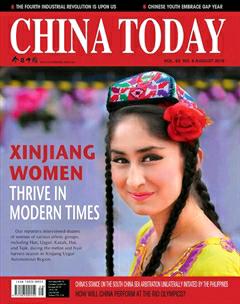Kashgar,Star of the Ancient Western Regions

KASHGAR in Xinjiang Uygur Autonomous Region is the westernmost major city of China. In the Uygur language, Kashgar means “a place like a fine jade.” The frontier city enjoys a written history of more than 2,100 years. It is the center of southern Xinjiangs politics, economy and culture, and also the largest farm and pasture products distribution center in this area. For millennia, it has been a key node on the ancient Silk Road, connecting the Eastern and Western worlds.
History
Located in the north of the Pamir Plateau and the western edge of the Taklimakan Desert, Kashgar is home to 31 ethnic groups including the Uygur, Han, Tajik, and Kyrgyz.
Bound by Tajikistan, Afghanistan, and Pakistan, Kashgars border runs up to 888 kilometers. In addition, it is also close to Kyrgyzstan, Uzbekistan, and India. All this has shaped it into the most convenient international thoroughfare connecting China and Central, South, and West Asia as well as Europe.
Zhang Qian (164-114 BC), imperial envoy of the Han Dynasty (206 BC-AD 220), visited Kashgar (then called Shule) during his mission in 119 BC to seek alliances with the people living in the Western Regions. In 60 BC, to ensure the Silk Road stayed untrammelled, the Han Dynasty set up a Western Regions Command in Xinjiang, officially incorporating Kashgar into Chinese territory. Throughout the Tang Dynasty (618-907), Kashgar was one of the four key military strongholds in the Western Regions.
During the Yuan Dynasty (1271-1368), Kashgar was the fiefdom of Chagatai Khan, Genghis Khans second son. In the 19th century, the Qing Dynasty(1644-1911) nominated the minister for Xingjiang af- fairs who was stationed in Kashgar.
Before the maritime Silk Road opened in the 15th century, Kashgar was a renowned transportation confluence of the south, north and central branches of the ancient Silk Road. Enjoying a long trade history with Central, South and West Asia as well as Europe, it was an international commercial hub, dubbed the “Oriental Cairo.”
Rich Ethnic Flavors
Kashgar, the birthplace of Uygur culture where Uygurs are the dominant community, is also regarded as the most representative Uygur city in Xinjiang with a distinctive culture, art and architectural style. The Uygurs follow Islam and their attire, food and customs display Islamic influence.
Kashgar is also famed as the “home of songs and dances.” Its songs and dances spread to Chinas Central Plain area during the Sui (581-618) and Tang dynasties, and were very popular in Changan, then the capital city. The Uygur people, no matter what their age, sing or dance whenever they are in the mood or on appropriate occasions. The 12 Muqams, a set of Uygur music, and folk dances such as Maxrap are considered a rare art treasure.

The Uygurs clothes and accessories are eyecatching and diverse. Men usually wear a long robe over their shirt which falls to the knee and has no fasteners. Around the waist, they wrap a long belt tucked with odds and ends. Women are fond of bright colors and wear dresses as well as ornamentations like earrings, bracelets, necklaces and rings, and headscarves in fabulous patterns. They also pencil their eyebrows and color their fingernails. Unmarried girls have long hair worn in as many as 10 plaits. Uygurs of all ages wear four-corner caps with exquisite embroidery and long boots.
Uygur houses are mostly bungalows with flat roofs where clothes are dried and people assemble to enjoy the cool air. The roofs have skylights. At the northeast edge of the old Kashgar town, there are still traditional Uygur clusters. The houses are usually built against cliffs. As the family increases, a new floor or an annexe is added to the house. Amid these haphazardly built houses, 50-odd lanes run criscross, leading to wherever you want to go. This forms Kashgars most distinctive terraced folk house area.
The Uygurs have a strong sense of family. In a large residential compound, there may be up to 20 rooms on different floors with wings attached to the main building. Different generations of the same family live in the same compound. Only after visiting these terraced houses can you understand Uygur culture and life.
In 2009, the Kashgar municipal government started a renovation project earmarking more than RMB 7 billion to reinforcing traditional folk buildings and preserving their original flavor. When the project is finished, residents problems like limited running water, old toilets and how to dispose of garbage will be resolved.
Diverse Culture
Kashgar is a confluence of the four civilizations of the world, namely, ancient Chinese civilization, ancient Indian civilization, and Christian and Islamic civilizations.
Since Zhang Qian set foot in the Western Regions in 119 BC, Kashgar began to come under the influence of Chinese culture. In the same period, Buddhism also spread to the city, later becoming the dominant religion for the next 1,000 years. The once-splendid Buddhist culture shaped Kashgar into one of the four Buddhist cultural centers in the ancient Western Regions. Buddhist relics can still be found here.
Kashgar has seen other religions like shamanism, Zoroastrianism, Nestorianism, Buddhism, and Islam flourish. Different cultures and customs coexisted and influenced one another. Since the 10th century, as the Uygur community gradually took shape and Islam expanded to the region, the Buddhism gradually faded out. Islam began to dominate the region.
Due to the citys diversified cultural and religious background, Islam in Kashgar is also inclusive. Many mosque pillars have the lotus-shape bases that are commonly seen in Buddhist temples. Religion symbols like Buddhist swastikas and the Taoist Yin-Yang fish can also be found in mosques.
Some Western scholars say the essence of Xinjiang culture probably comes from the cultural diversity shaped by the Silk Road where Kshgar was an important commercial hub. Diverse cultures and ethnicities have created Kashgars unique charm.

